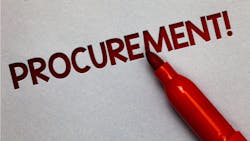Download this article in PDF format.
Turning the calendar page over to a new year—whether literally or figuratively—always brings out the prognosticators who are eager to share their opinions on what the next 12 months will bring for specific industries, organizations and professions. With 2020 now squarely in the rearview mirror, EY has taken a stab at outlining the 10 trends that it sees as crucial to the future of procurement.
In “Ten trends shaping the future of procurement,” the global consultancy admits that while it doesn’t have a magic crystal ball, it does have access to trends and leading-edge projects from around the world. Based on that intelligence, it has identified these trends that all procurement professionals should be aware of in 2021 and beyond (read the full list of trends here):
Procurement’s contribution to the overall organization strategy will drive competitive advantage. “Leading procurement functions will become part of an organization’s value stream and will be more influential in contributing to the overall business strategy, growth agenda, and competitive advantage,” EY predicts. Procurement leaders will be expanding their remit from a focus on cost leadership to enabling innovation, agility, and supply certainty.”
Procurement will be a more agile function that partners directly with business units. “Procurement will be a smaller, centralized function, with more happening in a virtual center and with people geographically embedded within business units, meeting the need for increased collaboration,” EY points out. It says category managers will also become business partners focusing on all procurement and category needs of a business unit, and that specialist knowledge and expertise will be obtained by leveraging the “gig economy” on an as-needed basis.
The data captured from the Internet of Things (IoT) will enable real-time tracking and monitoring of outcomes through continuous feedback loops across assets. “Asset-intensive industries will effectively link this data across the enterprise and connect to suppliers, enabling touchless procurement in the next 24 months,” EY predicts, adding that this process will ultimately create an enhanced data platform to inform decision-making around spend and purchasing patterns, catalog content, supplier portfolios and contract fulfillment.
Organizations will use internal and external data sources to better assess supplier risk. In the near future, most organizations will have a 360-deg. view of suppliers through internal data, data from suppliers, market data and external data on suppliers’ performance (e.g., performance of suppliers with other organizations). “This will not only provide historical data about supplier performance,” EY points out, “but will also enable organizations to accurately and holistically establish supplier risk profiles and to predict risk events.”
Voice-activated and bot-purchasing experiences will be the norm. “Buyers of the future will be supported by seamless and intuitive purchasing experiences, regardless of underlying technology systems already in place,” EY states. For example, think voice-activated purchasing experiences for goods and services, supported by natural-language search and virtual assistants.
Blockchain will be selectively used in procurement. “There will be some hesitation on implementing private blockchain networks due to the costs of development and deployment,” EY predicts, adding that blockchain use will most likely be limited to scenarios (i.e., where there is regulatory track-and-trace requirement, high levels of counterfeiting or a clear business case for operational integrity).
EY says that these are just “some of the waves in a sea change” that will help shape a more integrated and value-add procurement function in 2021 and beyond. “It’s clear that procurement leaders of the future must adapt to make sense of the new capabilities and technologies that are coming soon,” it concludes. “With the future just around the corner, now is the time for an organization to define a clear procurement strategy and roadmap to embrace, and use disruptive technologies instead of being consumed by them.”
About the Author

Bridget McCrea
Contributing Writer | Supply Chain Connect
Bridget McCrea is a freelance writer who covers business and technology for various publications.







